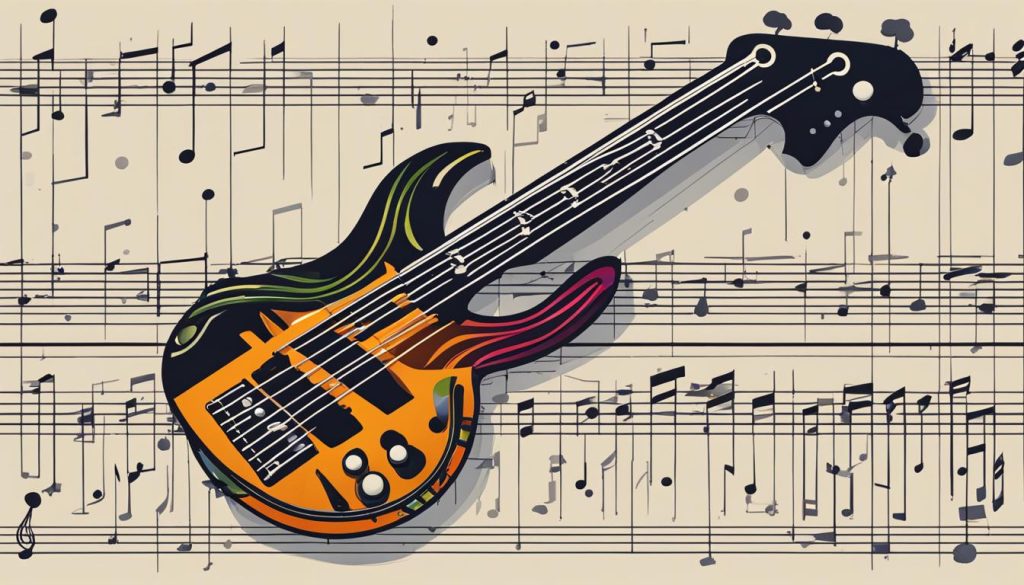Are you looking to take your bass guitar skills to the next level? One of the fundamental aspects to focus on is mastering key rhythm techniques. As a bass guitarist, your role is more than just laying down the foundation; you are responsible for keeping the beat strong and driving the groove of the music.
In this article, I will guide you through the basics of rhythm and provide you with essential knowledge to enhance your rhythmic abilities on the bass guitar. We will explore concepts such as bars, time signatures, tempo, and different rhythmic patterns that will elevate your playing and make you a more versatile musician.
Key Takeaways:
- Understanding bars, time signatures, and tempo is crucial for developing a strong sense of rhythm on the bass guitar.
- Mastering basic rhythmic patterns and counting aloud while tapping your foot to the beat will enhance your overall rhythmic abilities.
- Dotted notes add interesting variations to your playing and create more dynamic bass lines.
- Simplicity is key when it comes to bass guitar rhythm, focusing on solid timekeeping and maintaining a consistent rhythm.
- Using a metronome is a valuable tool for improving your rhythm skills and playing accurately with other musicians.
Understanding Musical Pulse and Time Signatures
In Western music, the rhythmic foundation is built upon bars, also known as measures. These bars serve as the recurring pulse, providing a steady beat to which you can tap your foot and maintain a consistent rhythm. Developed centuries ago, bars enable musicians to organize musical phrases and create a cohesive structure throughout a composition.
One crucial aspect of bars is the concept of time signatures. A time signature is represented as a fraction and indicates the number of beats in a bar. The top number represents the number of beats, while the bottom number denotes the type of note value that receives one beat. For example, common time, indicated by the symbol “4/4”, signifies four beats per bar, with each beat represented by a quarter note.
Understanding time signatures is essential for bass guitarists to develop a strong sense of rhythm. By recognizing the musical pulse and being aware of the number of beats in a bar, you can accurately interpret and perform different rhythmic patterns.
Let’s take a closer look at a few examples of time signatures:
| Time Signature | Beats per Bar | Example |
|---|---|---|
| 2/4 | Two beats per bar |  |
| 3/4 | Three beats per bar |  |
| 4/4 | Four beats per bar |  |
As you can see from the table, time signatures can vary, allowing for different rhythmic possibilities and musical expressions. By familiarizing yourself with common time signatures and their corresponding beats per bar, you can gain a solid foundation in rhythm.
“Understanding musical pulse and time signatures is fundamental to developing a strong sense of rhythm on the bass guitar.”
Developing a strong sense of musical pulse and mastering time signatures will significantly enhance your bass guitar skills and enable you to contribute to the overall groove and rhythm of a piece of music.
Exploring Tempo and Its Importance
When it comes to creating music, tempo is a vital element that sets the pace and energy of a piece. Tempo refers to the speed at which a musical composition is performed, whether it’s slow and solemn or fast and lively. As a bass guitarist, understanding tempo is crucial for maintaining a consistent rhythm and effectively supporting the overall groove of a song.

Tempo can be indicated in various ways, such as metronome markings or Italian terms commonly used in classical music. These markings provide specific instructions on the desired speed of the piece and help musicians stay in sync with one another.
The importance of tempo extends beyond simply keeping time. It plays a significant role in counting bars of music and navigating complex rhythms. By practicing at different tempos, bass guitarists can develop their adaptability and versatility, enabling them to play accurately in any tempo and genre.
“Tempo is like the heartbeat of a song—a steady pulse that guides the rest of the instruments. It’s what gives a composition its character and emotion.”
Practicing with a Metronome
One effective tool for developing a strong sense of tempo is the metronome. A metronome is a device that produces regular beats at a set tempo, allowing musicians to practice playing in time and staying consistent with their rhythm. The metronome serves as a reliable reference point, reinforcing the importance of keeping a steady beat.
By starting with basic quarter note rhythms and gradually increasing the tempo, bass guitarists can improve their timekeeping skills and build a solid sense of rhythm. Regular practice with a metronome not only enhances a musician’s ability to stay in time but also fosters a deep understanding of different tempos and their impact on musical expression.
The Role of Tempo in Musical Interpretation
Tempo is not just a fixed element in music; it can be interpreted and adjusted to suit the desired artistic expression. A slower tempo can create a contemplative and melancholic mood, while a faster tempo can evoke excitement and energy.
As a bass guitarist, it is essential to understand the intended tempo of a composition and adapt your playing accordingly. This involves listening to the ensemble and paying attention to the conductor or band leader’s cues. By mastering the art of tempo interpretation, bass guitarists can skillfully contribute to the musical dynamics and enhance the overall quality of the performance.
Summary
Tempo plays a fundamental role in music, serving as the driving force that dictates the speed and energy of a composition. For bass guitarists, understanding and mastering tempo is crucial for maintaining a consistent rhythm and adapting to different musical styles. By practicing with a metronome and developing a deep sense of tempo, bass guitarists can unlock their full potential and create captivating bass lines that groove with precision and musicality.
| Key Takeaways: | |
|---|---|
| Tempo is the speed at which music is played and is crucial for maintaining a consistent rhythm. | Bass guitarists can practice at different tempos to improve adaptability and accuracy in their playing. |
| Using a metronome can help bass guitarists develop a strong sense of tempo and improve timekeeping skills. | Tempo can be interpreted and adjusted to suit the desired artistic expression of a musical piece. |
Mastering Basic Rhythmic Patterns
Now that you have a solid understanding of time signatures and tempo, it’s time to delve into basic rhythmic patterns that will elevate your bass guitar playing. These patterns involve playing specific note durations and counting them aloud while tapping your foot to the beat. By practicing these patterns consistently, you will enhance your overall sense of rhythm and become a more dynamic bass guitarist.
Let’s start with the foundational rhythmic patterns: whole notes, half notes, quarter notes, and eighth notes. Each of these note durations contributes to the rhythmic structure of a piece of music and adds depth to your bass lines. By mastering the basics, you will develop the necessary skills to play more complex patterns and create captivating rhythms on your bass guitar.
Remember, rhythm is the heartbeat of music, and as a bass guitarist, you have the power to drive the groove and keep the band in sync. Through dedicated practice and a deep understanding of basic rhythmic patterns, you will become a rhythm powerhouse on the bass guitar.
Below is a table outlining the durations and counting methods for each basic rhythmic pattern:
| Note Duration | Number of Beats | Counting Method |
|---|---|---|
| Whole Note | 4 | 1, 2, 3, 4 |
| Half Note | 2 | 1, 2 |
| Quarter Note | 1 | 1 |
| Eighth Note | 0.5 | 1 & 2 & |
By referring to this table and practicing these rhythmic patterns, you will develop a strong foundation and improve your overall rhythm skills on the bass guitar. Remember to start slow, use a metronome for accuracy, and gradually increase your speed as you become more comfortable.
“The rhythm is about focus, feeling, and precision. It’s the backbone of any great bass line.” – Marcus Miller
To further illustrate the basic rhythmic patterns, let’s take a look at an example. In the table below, you’ll find a short bassline using these patterns:
| Measure | Beat 1 | Beat 2 | Beat 3 | Beat 4 |
|---|---|---|---|---|
| 1 | Quarter Note | Quarter Note | Quarter Note | Quarter Note |
| 2 | Half Note | Rest | Quarter Note | Quarter Note |
| 3 | Eighth Note | Eighth Note | Quarter Note | Eighth Note |
| 4 | Quarter Note | Quarter Note | Quarter Note | Quarter Note |

As you can see from the example, the bassline incorporates a variety of note durations to create a rhythmic foundation for the music. By practicing and mastering these basic rhythmic patterns, you will be able to create your own basslines that drive the groove and add depth to any musical composition.
Exploring Dotted Notes and Their Length
In the realm of rhythm, dotted notes play a significant role in adding complexity and creativity to bass guitar playing. These unique notes are easy to identify, as they feature a dot placed to the right of their stem. This simple dot holds the power to transform the length and timing of a note.
So, how does it work? When a dot is added to a note, it increases the original note’s length by half. This means that a dotted half note, typically equivalent to two beats, now becomes three beats. Similarly, a dotted quarter note, which usually spans one beat, extends to one and a half beats. The dot essentially adds half of the original note’s value, resulting in a prolonged duration and a distinctive rhythmic effect.
By understanding and incorporating dotted notes into your bass guitar playing, you can introduce captivating variations to your rhythm. These dotted notes create a sense of anticipation and tension, adding dynamic and expressive elements to your bass lines. Experimenting with different combinations of dotted notes and regular notes allows you to create intricate rhythmic patterns and infuse your playing with a unique flavor.
Let’s take a closer look at the lengths of some commonly used dotted notes:
| Dotted Note | Original Length | Modified Length |
|---|---|---|
| Dotted Half Note | 2 beats | 3 beats |
| Dotted Quarter Note | 1 beat | 1.5 beats |
| Dotted Eighth Note | 0.5 beats | 0.75 beats |
As you can see, incorporating dotted notes into your bass guitar playing offers a range of rhythmic possibilities. By mastering these dotted notes and their lengths, you can add complexity and sophistication to your bass lines, captivating listeners with your rhythmic prowess.
The Importance of Keeping It Simple
When it comes to bass guitar rhythm, simplicity is key. Many well-known bass lines in popular songs are based on simple rhythmic patterns that effectively support the melody and groove of the music. As a bass guitarist, I understand the importance of prioritizing solid timekeeping and maintaining a consistent rhythm.
Building a strong foundation with simple rhythms enables me to contribute to the overall musicality of a song and create a solid groove. By focusing on simplicity, I can enhance the rhythmic drive and provide a solid backbone for the rest of the band.
“Simplicity is the ultimate sophistication.” – Leonardo da Vinci
By keeping it simple, I am able to lock in with the drummer and establish a tight pocket. This lays the groundwork for other instrumentalists to build upon and adds cohesion to the music. Simple bass lines can be incredibly effective in bringing out the harmonic and rhythmic aspects of a song.
Additionally, simplicity allows for greater musical expression. By simplifying complex rhythms, I can focus on playing with intention and adding subtle variations to enhance the overall groove. It’s all about finding the balance between keeping it simple and adding tasteful embellishments when appropriate.
The Power of Simplicity in Bass Guitar Rhythm
Here are a few reasons why simplicity is so important when it comes to bass guitar rhythm:
- Provides a solid foundation for the rest of the band
- Allows for better synchronization with the drummer
- Enhances the overall musicality of a song
- Allows for greater creative expression
When I simplify my approach to bass guitar rhythm, I can focus on the essentials and ensure that the groove remains tight and locked in. It’s about finding the right balance between simplicity and musicality to serve the song and create a compelling rhythm section.
In conclusion, simplicity plays a crucial role in bass guitar rhythm. By prioritizing solid timekeeping and simplifying rhythmic patterns, bass guitarists can create a strong foundation for the music and enhance the overall groove. The power of simplicity lies in its ability to bring out the essence of a song and allow for greater creativity and expression. So, remember to keep it simple and let the rhythm flow.
Using a Metronome to Develop Rhythm Skills
A metronome is an invaluable tool for bass guitarists looking to enhance their rhythm skills. By utilizing a metronome, you can improve your ability to play in time and maintain a consistent rhythm. Setting the metronome to a specific tempo allows you to practice different rhythmic patterns while staying synchronized with the beat.
To get started, begin with basic quarter note rhythms. Play along with the metronome, making sure to match your playing precisely with each click. As you become more comfortable, gradually increase the tempo to challenge yourself with faster-paced rhythms. This progressive approach will help you build your rhythm skills and adapt to a variety of musical styles.
Practicing with a metronome regularly is essential for developing a solid sense of timing and precision. It trains your internal clock and trains your ear to recognize subtle variations in timing. By honing your rhythm skills, you’ll be able to play accurately with other musicians, maintain a steady groove, and elevate your bass playing to new heights.
Remember to start slow and gradually work your way up to faster tempos. Consistency in practice is key, as it allows your muscle memory to develop and your rhythmic abilities to flourish.
Conclusion
The art of mastering rhythm techniques is paramount for bass guitarists aiming to take their playing to new heights and enhance the overall musicality of a song. As a bass guitarist, I understand the importance of honing rhythmic skills to create a solid foundation for any musical composition. By delving into the intricacies of musical pulse, time signatures, tempo, and practicing various rhythmic patterns, I have developed a strong sense of rhythm that allows me to adapt to any musical style with ease.
Consistent practice is key to unlocking the full potential of rhythmic abilities on the bass guitar. By dedicating time and effort to practicing with tools like metronomes, bass guitarists can polish their sense of timing, precision, and accuracy. This not only enhances their individual playing but also allows them to seamlessly blend with other musicians to create a cohesive and dynamic musical experience.
In conclusion, mastering rhythm techniques is a vital aspect of the bass guitarist’s journey. By understanding the nuances of rhythm and consistently refining skills through practice, bass guitarists can become versatile musicians capable of elevating the musicality of any song they contribute to. So, embrace the rhythm, explore the possibilities, and let your bass guitar groove in perfect sync with the beat!
FAQ
What are some key rhythm techniques for bass guitarists?
Some key rhythm techniques for bass guitarists include understanding bars and time signatures, mastering different rhythmic patterns, and developing a strong sense of tempo.
What is musical pulse and why is it important?
Musical pulse refers to the recurring pulse or beat to which you tap your foot in music. It is important because it helps you maintain a consistent rhythm and understand the organization of beats in a piece of music.
Why is tempo important in rhythm?
Tempo refers to the speed at which a piece of music is played. It is important in rhythm because it helps you count bars of music and play accurately in different musical styles and tempos.
How can I master basic rhythmic patterns on the bass guitar?
To master basic rhythmic patterns on the bass guitar, start by practicing with whole notes, half notes, quarter notes, and eighth notes. By counting these note durations aloud and tapping your foot to the beat, you can gradually progress to more complex patterns.
What are dotted notes and how can they be used in bass guitar playing?
Dotted notes are notes with a dot placed to the right of their stem, which adds half of the note’s value to its length. Bass guitarists can use dotted notes to add interesting rhythmic variations and create more dynamic and expressive bass lines.
Why is simplicity important in bass guitar rhythm?
Simplicity is important in bass guitar rhythm because many well-known bass lines in popular songs are based on simple rhythmic patterns. Prioritizing solid timekeeping and maintaining a consistent rhythm helps contribute to the overall musicality and groove of a song.
How can I use a metronome to develop rhythm skills?
Using a metronome can help develop rhythm skills by setting it to a specific tempo and practicing playing in time with the metronome. Start with basic quarter note rhythms and gradually increase the tempo to challenge yourself with more complex patterns.
How can I elevate my bass guitar playing with rhythm techniques?
To elevate your bass guitar playing with rhythm techniques, it is important to understand musical pulse, time signatures, tempo, and practice various rhythmic patterns consistently. Utilizing tools like metronomes can also help improve your ability to keep a steady rhythm and play accurately with other musicians.
Source Links
- https://www.talkingbass.net/beginners-guide-to-rhythm-for-bass-players/
- https://bassroad.net/bass-rhythm-comes-first/
- http://bassguitarplayerworld.com/beginner/easy-rhythms/

Bass Punch
Bass Punch is curated by a group of passionate guitarists and bassists, offering a wealth of informational content. This collective of experts shares their insights, techniques, and knowledge with readers, aiming to educate and inspire enthusiasts across all levels of proficiency. The blog serves as a hub for those seeking to deepen their understanding of bass and guitar, providing valuable resources and guidance from seasoned professionals in the field.
